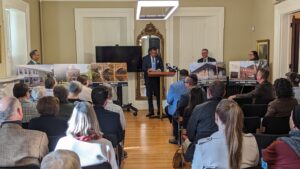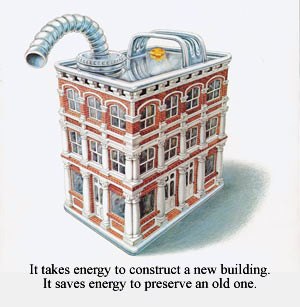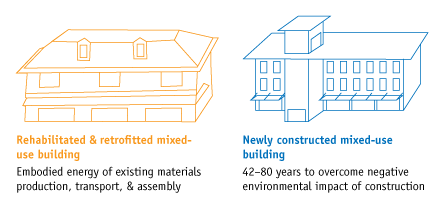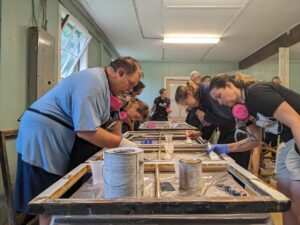
Historic Preservation and the Planet
- May 8, 2018
- 3:28 pm
- May 8, 2018
- 3:28 pm
 Written by Caitlin Meives, The Landmark Society’s Preservation Planner
Written by Caitlin Meives, The Landmark Society’s Preservation Planner
The Landmark Society went “green” long before reusable shopping bags, LEED certification, and organic shampoo became popular: historic preservation is the ultimate recycling. As an organization that advocates for and fosters preservation, we have been practicing sustainability for more than 80 years. While preservation is a critical component in revitalizing urban communities and rural villages, it is also central to smart growth and environmentally sustainable development.
When most people imagine a “green” building though, they probably think of a glamorous new building with solar panels, a rooftop garden, and other cutting-edge technology. The environmental value of the reuse, or continued use, of historic buildings gets less attention than it should. Here are just a few reasons why preservation has always been a green activity:
1. Reusing buildings reduces landfill waste. The demolition of buildings in the United States generates at least 124 million tons of debris each year. Every building that is saved and reused is one less pile of brick, wood, stone and glass in the landfill.
2. Redeveloping urban areas preserves undeveloped land. Reinvesting in historic neighborhoods – for example, by reusing vacant historic buildings – preserves open space, farmland, and natural habitats by diverting development away from undeveloped areas.
3. Historic neighborhoods encourage transportation alternatives. Sidewalks, higher density, and mixed uses encourage walking, biking, and public transit – and are features typically found in historic neighborhoods. Low-density suburban residential and commercial development, on the other hand, encourages an automobile-reliant lifestyle. Residents of suburban developments have to drive everywhere and have longer commutes (on average), which translates to increased usage of fossil fuels. Compact, walkable neighborhoods are friendlier to the environment, and have been shown to be healthier: studies have shown a direct link between areas with sprawl characteristics and higher rates of obesity and associated diseases.
4. Historic buildings were built to last. Historic buildings have already survived 50 or more years and, due to typically higher qualities of materials and construction techniques, can often be expected to last many more years. Generally, new construction is limited to a 20- to 40-year life expectancy.
5. Historic buildings incorporate climate-sensitive design techniques. Traditional features such as operable shutters, courtyards, double-hung windows with operable upper and lower sash, porches, real masonry construction, and appropriate roof pitch naturally help to keep a building warm in winter and/or cool in summer. These attributes can contribute to reductions in energy usage.
6. Considering “embodied energy” can tip the scales. New buildings, especially those that incorporate “green” elements like thermal-pane windows and solar panels, are often thought of as more energy-efficient than historic buildings because of their reduced energy usage, and we can all applaud efforts to improve efficiency. But what about the energy expended in constructing them? When “embodied energy,” defined by Mike Jackson of the Illinois Historic Preservation Agency as “the sum of all the energy required to extract, process, deliver, and install the materials needed to construct a building,” is taken into account, it can take at least three to five decades (which is longer than the expected life span of many new buildings) to realize any life-cycle energy savings through the construction of an energy-efficient building. This is especially true when the environmental impact of abandoning or demolishing an existing building is also factored in.

7. The quality of historic building materials cannot be replicated. Historic buildings were constructed of natural, indigenous materials such as old-growth wood, brick, and stone. These materials were also very durable and in some cases either renewable or reusable. They are usually prohibitively expensive today, if they are available at all. While there are exceptions, many of the materials used today are less durable, are mass-produced (sometimes using processes and products that are harmful to the environment and/or to human health), and are transported great distances from their point of origin to construction sites. To discard traditional building materials and quality craftsmanship in favor of less-durable, mass-produced construction seems the height of wastefulness.
8. Reusing historic buildings and neighborhoods recycles existing infrastructure.Established neighborhoods already have the sewers, roads, sidewalks, and other infrastructure elements that support development. Duplicating these facilities by extending new infrastructure into undeveloped areas is often an unnecessary use of materials, energy, and taxpayers’ money, and also encourages more sprawl and land consumption as development follows infrastructure improvements.
To learn much more about this topic, see the National Trust’s Preservation Green Lab.
SHARE




